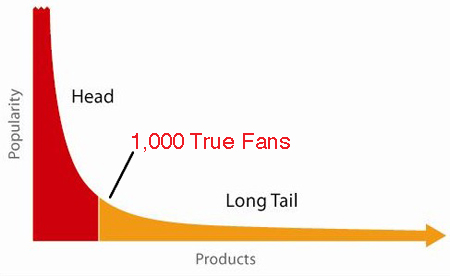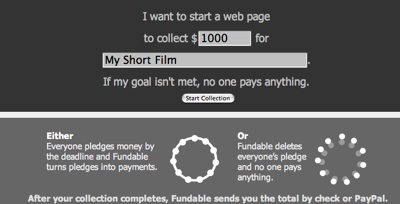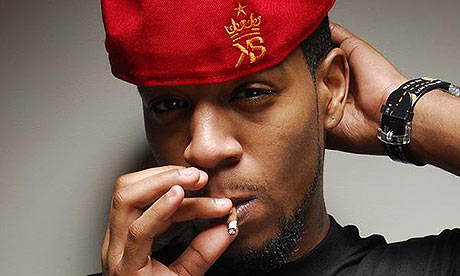1,000 True Fans
The long tail is famously good news for two classes of people; a few lucky aggregators, such as Amazon and Netflix, and 6 billion consumers. Of those two, I think consumers earn the greater reward from the wealth hidden in infinite niches.
But the long tail is a decidedly mixed blessing for creators. Individual artists, producers, inventors and makers are overlooked in the equation. The long tail does not raise the sales of creators much, but it does add massive competition and endless downward pressure on prices. Unless artists become a large aggregator of other artist's works, the long tail offers no path out of the quiet doldrums of minuscule sales.
Other than aim for a blockbuster hit, what can an artist do to escape the long tail?
One solution is to find 1,000 True Fans. While some artists have discovered this path without calling it that, I think it is worth trying to formalize. The gist of 1,000 True Fans can be stated simply:
A creator, such as an artist, musician, photographer, craftsperson, performer, animator, designer, videomaker, or author - in other words, anyone producing works of art - needs to acquire only 1,000 True Fans to make a living.
A True Fan is defined as someone who will purchase anything and everything you produce. They will drive 200 miles to see you sing. They will buy the super deluxe re-issued hi-res box set of your stuff even though they have the low-res version. They have a Google Alert set for your name. They bookmark the eBay page where your out-of-print editions show up. They come to your openings. They have you sign their copies. They buy the t-shirt, and the mug, and the hat. They can't wait till you issue your next work. They are true fans.

To raise your sales out of the flatline of the long tail you need to connect with your True Fans directly. Another way to state this is, you need to convert a thousand Lesser Fans into a thousand True Fans.
Assume conservatively that your True Fans will each spend one day's wages per year in support of what you do. That "one-day-wage" is an average, because of course your truest fans will spend a lot more than that. Let's peg that per diem each True Fan spends at $100 per year. If you have 1,000 fans that sums up to $100,000 per year, which minus some modest expenses, is a living for most folks.
One thousand is a feasible number. You could count to 1,000. If you added one fan a day, it would take only three years. True Fanship is doable. Pleasing a True Fan is pleasurable, and invigorating. It rewards the artist to remain true, to focus on the unique aspects of their work, the qualities that True Fans appreciate.
The key challenge is that you have to maintain direct contact with your 1,000 True Fans. They are giving you their support directly. Maybe they come to your house concerts, or they are buying your DVDs from your website, or they order your prints from Pictopia. As much as possible you retain the full amount of their support. You also benefit from the direct feedback and love.
The technologies of connection and small-time manufacturing make this circle possible. Blogs and RSS feeds trickle out news, and upcoming appearances or new works. Web sites host galleries of your past work, archives of biographical information, and catalogs of paraphernalia. Diskmakers, Blurb, rapid prototyping shops, Myspace, Facebook, and the entire digital domain all conspire to make duplication and dissemination in small quantities fast, cheap and easy. You don't need a million fans to justify producing something new. A mere one thousand is sufficient.
This small circle of diehard fans, which can provide you with a living, is surrounded by concentric circles of Lesser Fans. These folks will not purchase everything you do, and may not seek out direct contact, but they will buy much of what you produce. The processes you develop to feed your True Fans will also nurture Lesser Fans. As you acquire new True Fans, you can also add many more Lesser Fans. If you keep going, you may indeed end up with millions of fans and reach a hit. I don't know of any creator who is not interested in having a million fans.
But the point of this strategy is to say that you don't need a hit to survive. You don't need to aim for the short head of best-sellerdom to escape the long tail. There is a place in the middle, that is not very far away from the tail, where you can at least make a living. That mid-way haven is called 1,000 True Fans. It is an alternate destination for an artist to aim for.
Young artists starting out in this digitally mediated world have another path other than stardom, a path made possible by the very technology that creates the long tail. Instead of trying to reach the narrow and unlikely peaks of platinum hits, bestseller blockbusters, and celebrity status, they can aim for direct connection with 1,000 True Fans. It's a much saner destination to hope for. You make a living instead of a fortune. You are surrounded not by fad and fashionable infatuation, but by True Fans. And you are much more likely to actually arrive there.
A few caveats. This formula - one thousand direct True Fans -- is crafted for one person, the solo artist. What happens in a duet, or quartet, or movie crew? Obviously, you'll need more fans. But the additional fans you'll need are in direct geometric proportion to the increase of your creative group. In other words, if you increase your group size by 33%, you need add only 33% more fans. This linear growth is in contrast to the exponential growth by which many things in the digital domain inflate. I would not be surprise to find that the value of your True Fans network follows the standard network effects rule, and increases as the square of the number of Fans. As your True Fans connect with each other, they will more readily increase their average spending on your works. So while increasing the numbers of artists involved in creation increases the number of True Fans needed, the increase does not explode, but rises gently and in proportion.
A more important caution: Not every artist is cut out, or willing, to be a nurturer of fans. Many musicians just want to play music, or photographers just want to shoot, or painters paint, and they temperamentally don't want to deal with fans, especially True Fans. For these creatives, they need a mediator, a manager, a handler, an agent, a galleryist -- someone to manage their fans. Nonetheless, they can still aim for the same middle destination of 1,000 True Fans. They are just working in a duet.
Third distinction. Direct fans are best. The number of True Fans needed to make a living indirectly inflates fast, but not infinitely. Take blogging as an example. Because fan support for a blogger routes through advertising clicks (except in the occasional tip-jar), more fans are needed for a blogger to make a living. But while this moves the destination towards the left on the long tail curve, it is still far short of blockbuster territory. Same is true in book publishing. When you have corporations involved in taking the majority of the revenue for your work, then it takes many times more True Fans to support you. To the degree an author cultivates direct contact with his/her fans, the smaller the number needed.
Lastly, the actual number may vary depending on the media. Maybe it is 500 True Fans for a painter and 5,000 True Fans for a videomaker. The numbers must surely vary around the world. But in fact the actual number is not critical, because it cannot be determined except by attempting it. Once you are in that mode, the actual number will become evident. That will be the True Fan number that works for you. My formula may be off by an order of magnitude, but even so, its far less than a million.
I've been scouring the literature for any references to the True Fan number. Suck.com co-founder Carl Steadman had theory about microcelebrities. By his count, a microcelebrity was someone famous to 1,500 people. So those fifteen hundred would rave about you. As quoted by Danny O'Brien, "One person in every town in Britain likes your dumb online comic. That's enough to keep you in beers (or T-shirt sales) all year."
Others call this microcelebrity support micro-patronage, or distributed patronage.
In 1999 John Kelsey and Bruce Schneier published a model for this in First Monday, an online journal. They called it the Street Performer Protocol.
Using the logic of a street performer, the author goes directly to the readers before the book is published; perhaps even before the book is written. The author bypasses the publisher and makes a public statement on the order of: "When I get $100,000 in donations, I will release the next novel in this series."
Readers can go to the author's Web site, see how much money has already been donated, and donate money to the cause of getting his novel out. Note that the author doesn't care who pays to get the next chapter out; nor does he care how many people read the book that didn't pay for it. He just cares that his $100,000 pot gets filled. When it does, he publishes the next book. In this case "publish" simply means "make available," not "bind and distribute through bookstores." The book is made available, free of charge, to everyone: those who paid for it and those who did not.
In 2004 author Lawrence Watt-Evans used this model to publish his newest novel. He asked his True Fans to collectively pay $100 per month. When he got $100 he posted the next chapter of the novel. The entire book was published online for his True Fans, and then later in paper for all his fans. He is now writing a second novel this way. He gets by on an estimated 200 True Fans because he also publishes in the traditional manner -- with advances from a publisher supported by thousands of Lesser Fans. Other authors who use fans to directly support their work are Diane Duane, Sharon Lee and Steve Miller, and Don Sakers. Game designer Greg Stolze employed a similar True Fan model to launch two pre-financed games. Fifty of his True Fans contributed seed money for his development costs.
The genius of the True Fan model is that the fans are able to move an artist away from the edges of the long tail to a degree larger than their numbers indicate. They can do this in three ways: by purchasing more per person, by spending directly so the creator keeps more per sale, and by enabling new models of support.
New models of support include micro-patronage. Another model is pre-financing the startup costs. Digital technology enables this fan support to take many shapes. Fundable is a web-based enterprise which allows anyone to raise a fixed amount of money for a project, while reassuring the backers the project will happen. Fundable withholds the money until the full amount is collected. They return the money if the minimum is not reached.

Here's an example from Fundable's site;
Amelia, a twenty-year-old classical soprano singer, pre-sold her first CD before entering a recording studio. "If I get $400 in pre-orders, I will be able to afford the rest [of the studio costs]," she told potential contributors. Fundable's all-or-nothing model ensured that none of her customers would lose money if she fell short of her goal. Amelia sold over $940 in albums.
A thousand dollars won't keep even a starving artist alive long, but with serious attention, a dedicated artist can do better with their True Fans. Jill Sobule, a musician who has nurtured a sizable following over many years of touring and recording, is doing well relying on her True Fans. Recently she decided to go to her fans to finance the $75,000 professional recording fees she needed for her next album. She has raised close to $50,000 so far. By directly supporting her via their patronage, the fans gain intimacy with their artist. According to the Associated Press:
Contributors can choose a level of pledges ranging from the $10 "unpolished rock," which earns them a free digital download of her disc when it's made, to the $10,000 "weapons-grade plutonium level," where she promises "you get to come and sing on my CD. Don't worry if you can't sing - we can fix that on our end." For a $5,000 contribution, Sobule said she'll perform a concert in the donor's house. The lower levels are more popular, where donors can earn things like an advanced copy of the CD, a mention in the liner notes and a T-shirt identifying them as a "junior executive producer" of the CD.
The usual alternative to making a living based on True Fans is poverty. A study as recently as 1995 showed that the accepted price of being an artist was large. Sociologist Ruth Towse surveyed artists in Britian and determined that on average they earned below poverty subsistence levels.
I am suggesting there is a home for creatives in between poverty and stardom. Somewhere lower than stratospheric bestsellerdom, but higher than the obscurity of the long tail. I don't know the actual true number, but I think a dedicated artist could cultivate 1,000 True Fans, and by their direct support using new technology, make an honest living. I'd love to hear from anyone who might have settled on such a path.





 Remember how you used to go to hundreds of gigs as a lithe young twentysomething, full of the joys of live music? And cider’n'black, obviously.
Remember how you used to go to hundreds of gigs as a lithe young twentysomething, full of the joys of live music? And cider’n'black, obviously.






 The Banquet
The Banquet  The Sound System
The Sound System

